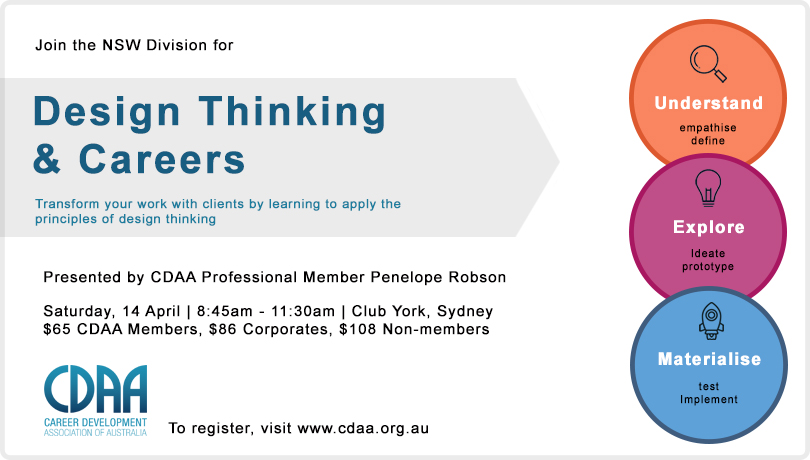Design Thinking and Careers
23/03/18

What is Design Thinking?
Design thinking is a method of creative problem solving used to produce novel solutions to practical problems. Whilst originally used primarily for solving design problems, this method of thinking is now used to tackle problems in a range of settings. At its core, design thinking involves using creative thinking and models to posit a range of innovative solutions to a given problem.
Design Thinking and Careers
Design thinking is effective where there is incomplete information or the desired result is unknown, thus it has proved to be a useful lens through which to consider career decisions. Stanford professors Bill Burnett and Dave Evans decided to employ design thinking in the careers context after noticing that the traditional logical analytical approach to career planning was not working for students who did not know what they were looking for in their careers. Consequently, Burnett and Evans developed a process that incorporated design thinking to help individuals come up with a range of possible career paths. Central to this process is the notion that individuals don’t decide their way forward, but rather use design thinking to build their way forward to the “next version” of themselves.
The Process
There are seven steps in the process. Namely, the client needs to:
- accept where they are now;
- establish connections between their views on work and life, thereby establishing a direction that they can reorient themselves to at any time ( “I won’t always know where I’m going, but I’ll know I’m going in the right direction”);
- determine what the real problem is before jumping in to find the solution. This involves distinguishing between problems that are actionable, and circumstances that can’t be solved;
- move forward, using energy and engagement as the clues;
- ideate three viable five-year plans;
- prototype aspects of the three plans, enabling them to experience ‘potential futures’; and
- choose one of the paths (There is no right choice, only good choosing”).
The Mindsets
There are a number of mindsets that a client must adopt when undertaking the process. These include:
- being curious;
- reframing problems;
- being mindful of the process;
- collaborating with others (as ideas emerge from collective perspectives);
- and having a bias towards action (“Experiment. Do something, especially when in doubt”).
What is different about the methodology?
- Each of the seven steps involve well-designed exercises to accelerate a client’s awareness e.g. during step one, clients assess where they are “right now” in the spheres of work, play, love and health by colouring in a dashboard which ranges from low to high allowing them to quickly see which spheres they are neglecting.
- The authors expose and reframe dysfunctional beliefs and assumptions that prevent people from exploring new perspectives e.g. “I have to find the one right idea”, is reframed, as “I need a lot of ideas so that I can explore any number of possibilities”.
- The method overcomes the problem of people getting stuck trying to make their first idea work. Design thinkers never choose the first solution to any problem. The idea is that there is no one “big idea” for your life; there are many lives you could happily and productively live.
- Developing three ideas in parallel enables clients to compare results and combine different components to shape their next step. If the mind starts with multiple ideas, it is not prematurely committed to one path and therefore stays open and receptive to novel ideas.
- Conceiving multiple prototypes prompts new and interesting questions and exposes hidden assumptions and biases. The value of prototyping has been validated by research at Stanford.
- Through tools such as ideating, brainstorming and experimenting, clients learn to choose well, using all the information available to them when making a decision.
- The program applies regardless of one's age, income or stage of life and has been piloted across 18 to 80 year olds. Additionally, there have been two PhD studies on the program confirming its efficacy.
Recommended reading
“Designing Your Life” by William Burnett and David J Evans, Albert A. Knopf, 2016
The Design Your Life website
Stanford University’s Crash Course in Design Thinking
About Penelope
Penelope is a qualified coach specialising in executive and personal coaching with a special interest in career choice and change. She runs her own business, Penelope Robson Coaching Services, offering executive and personal coaching services to both individuals and organisations.
www.peneloperobson.com.au
[email protected]